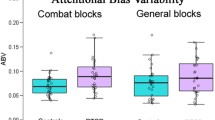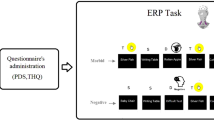Abstract
Conscious and preconscious processing of threatening information in posttraumatic stress disorder (PTSD) was studied using a masked modified Stroop paradigm. Twenty subjects who had been in motor vehicle accidents (MVAs) and met criteria for PTSD were compared with 20 MVA non-PTSD and 20 non-MVA subjects. PTSD subjects, but not MVA or non-MVA subjects, demonstrated greater interference on threat words in both the masked and unmasked conditions. The results suggest that preferential processing of threat-related information in PTSD occurs at a preconscious stage of processing.
Similar content being viewed by others
References
American Psychiatric Association. (1987).Diagnostic and statistical manual of mental disorders (3rd ed., rev.). Washington, DC: Author.
American Psychiatric Association. (1994).Diagnostic and statistical manual of mental disorders (4th ed.). Washington, DC: Author.
Bryant, R. A., & Harvey, A. G. (1995). Processing threatening information in posttraumatic stress disorder.Journal of Abnormal Psychology, 104, 537–554.
Carroll, J. B., Davies, P., & Richman, B. (1971).Word frequency book. Boston: Houghton Mifflin.
Cassiday, K. L., McNally, R. J., & Zeitlin, S. B. (1992). Cognitive processing of trauma cues in rape victims with posttraumatic stress disorder.Cognitive Therapy and Research, 16, 283–295.
Dalton, J. E., Pederson, S. L., & Ryan, J. J. (1989). Effects of posttraumatic stress disorder on neuropsychological test performance.International Journal of Clinical Neuropsychology, 11, 121–124.
Foa, E. B., Feske, U., Murdock, T. B., Kozak, M. J., & McCarthy, P. R. (1991). Processing of threat-related information in rape victims.Journal of Abnormal Psychology, 100, 156–162.
Foa, E. B., Steketee, G., & Rothbaum B. O. (1989). Behavioral/cognitive conceptualizations of posttraumatic stress disorder.Behavior Therapy, 20, 155–173.
Forster, K. I., & Forster, J. C. (1990).The DMASTER display system. Unpublished manuscript, University of Arizona.
Holender, D. (1986). Semantic activation without conscious identification in dichotic listening, parafoveal vision, and visual masking: A survey and appraisal.The Behavioral and Brain Sciences, 9, 1–66.
Horowitz, M., Wilner, N., & Alvarez, W. (1979). Impact of Event Scale: A measure of subjective stress.Psychosomatic Medicine, 41, 209–218.
Litz, B. T., & Keane, T. M. (1989). Information processing in anxiety disorders: Application to the understanding of post-traumatic stress disorder.Clinical Psychology Review, 9, 243–257.
MacLeod, C. (1990). Mood disorders and cognition. In M. W. Eysenck (Ed.),Cognitive psychology: An international review (pp. 9–55). New York: Wiley.
MacLeod, C., & Hagan, R. (1992). Individual differences in the selective processing of threatening information, and emotional responses to a stressful life event.Behaviour Research and Therapy, 30, 151–161.
MacLeod, C., & Rutherford, E. M. (1992). Anxiety and the selective processing of emotional information: Mediating roles of awareness, trait and state variables, and personal relevance of stimulus materials.Behaviour Research and Therapy, 30, 479–491.
McNally, R. J., English, G. E., & Lipke, H. J. (1993). Assessment of intrusive cognition in PTSD: Use of the modified Stroop paradigm.Journal of Traumatic Stress, 6, 33–41.
McNally, R. J., Kaspi, S. P., Riemann, B. C., & Zeitlin, S. B. (1990). Selective processing of threat cues in posttraumatic stress disorder.Journal of Abnormal Psychology, 99, 398–402.
Mogg, K., Bradley, B. P., Williams, R., & Mathews, A. (1993). Subliminal processing of emotional information in anxiety and depression.Journal of Abnormal Psychology, 102, 304–311.
Mogg, K., Kentish, J., & Bradley, B. P. (1993). Effects of anxiety and awareness on color-identification latencies for emotional words.Behaviour Research and Therapy, 31, 559–567.
Öhman, A. (1996). Preferential preattentive processing of threat in anxiety: Preparedness and attentional biases. In R. M. Rapee (Ed.),Current controversies in the anxiety disorders. (pp. 253–296). New York: Guilford Press.
Robins, L. N., & Helzer, J. E. (1985).Diagnostic Interview Schedule (DIS Version III-A). St. Louis, MO: Washington University, Department of Psychiatry.
Shore, J. H., Vollmer, W. M., & Tatum, E. L. (1989). Community patterns of posttraumatic stress disorder.Journal of Nervous and Mental Disease, 177, 681–685.
Spielberger, C. D., Gorsuch, R. C., Lushene, R. E., Vagg, P. R., & Jacobs, G. A. (1983).Manual for the State Trait Anxiety Inventory. Palo Alto, CA: Consulting Psychologists Press.
Thrasher, S. M., Dalgleish, T., & Yule, W. (1994). Information processing in posttraumatic stress disorder.Behaviour Research and Therapy, 32, 247–254.
Watson, C. G., Juba, M. P., Manifold, V., Kucala, T., & Anderson, P. E. D. (1991). The PTSD interview: Rationale, description, reliability, and concurrent validity of a DSM-III-based technique.Journal of Clinical Psychology, 47, 179–188.
Wechsler, D. (1981).Manual for the Wechsler Adult Intelligence Scale—Revised. San Antonio: The Psychological Corporation.
Williams, J. M. G., Watts, F. N., MacLeod, C., & Mathews, A. (1988).Cognitive psychology and emotional disorders. New York: Wiley.
Author information
Authors and Affiliations
Additional information
This project was supported by a grant from the Motor Accident Authority of NSW (Clinical Sciences Project No. 9743).
Rights and permissions
About this article
Cite this article
Harvey, A.G., Bryant, R.A. & Rapee, R.M. Preconscious processing of threat in posttraumatic stress disorder. Cogn Ther Res 20, 613–623 (1996). https://doi.org/10.1007/BF02227964
Issue Date:
DOI: https://doi.org/10.1007/BF02227964




